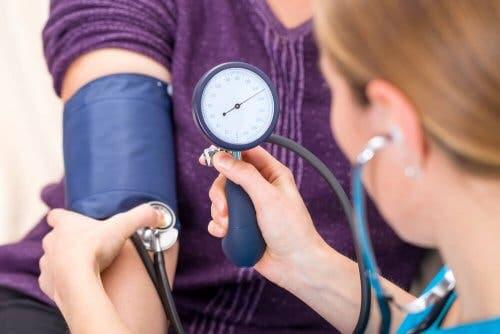5 Exercises for People With High Blood Pressure


Written and verified by the nutritionist Eliana Delgado Villanueva
According to information published by the Spanish Hearth Association, physical activity is ideal for treating patients with high blood pressure. This is thanks to the fact that exercise reduces levels of arterial pressure.
In 1989, after various studies, these experts also affirmed that the World Health Organization (WHO) and the International Society of Hypertension for the first time named physical exercise as a means of non-pharmacological prevention of this condition.
Before starting an exercise program, it’s crucial to consult with a doctor first. A professional will be able to suggest additional measures according to the health of each individual patient.
Below, you’ll find several physical exercises that patients with high blood pressure can perform.
What is hypertension?

Hypertension is an elevation in blood pressure levels in a continuous and sustained manner. In order to understand is better it’s important to define it. When the heart exercises tension on the arteries, they direct the blood towards different organs of the human body. This action is known as arterial pressure.
Each contraction obtains maximum pressure, also known as systolic pressure. At the same time, each relaxation establishes minimum pressure–or diastolic pressure.
You may also want to read: Yoga Can Help Control High Blood Pressure
The benefits of practicing sports for patients with high blood pressure
While it may seem incoherent, elevating the pulsation of patients who suffer from hypertension is not counterproductive. It’s important to emphasize that physical exercise reduces the levels of arterial tension. What’s more, it improves physical fitness and reduces risk factors that lead to chronic illness. The Spanish Hypertension Society published a study that demonstrated the following:
- First, patients with high blood pressure will progressively feel healthier and enjoy better physical fitness.
- Also, patients will maintain healthy body weight, thus preventing obesity.
- In the same way, physical activity helps the heart function better, reducing the number of beats per minute.
- Furthermore, it helps to prevent anxiety, depression, and stress.
- Last, physical exercise keeps arterial pressure under control as well as cholesterol and glucose levels.
How and what exercises to practice
The key is in the consistent practice of moderately intense exercises under the supervision of a specialist. People with high blood pressure that don’t suffer from heart failure can perform moderate exercises 3 or 4 times per week. For example, jogging at a good pace for intervals of 20 to 24 minutes is one possibility.
Rhythmic and aerobic exercises that involve various muscle groups are very effective for patients with hypertension. For example, walking, dancing, running, swimming, and bike riding.
Let’s take a look at a few and their specific benefits.
Exercises the patients with high blood pressure can perform
1. Bike riding

Bike riding is an ideal form of resistance training. It strengthens the cardiovascular system, metabolism, and the immune system. What’s more, it tones the muscles in the legs and back without overloading the joints. Arterial pressure increases at the beginning of this activity, although with time it can drop to a lower level.
2. Dancing
This activity is a positive complement for treatments that can help to reduce hypertension. It improves cardiovascular capacity and lowers cholesterol levels. What’s more, it reduces stress, which is one of the catalysts for high blood pressure.
3. Walking
A study by specialists from the HBP and Cardiovascular Risk Unit suggests a reason behind the incidence of hypertension in the general population today. According to the researchers, there’s a great deal of evidence to suggest that psychological factors are behind the current high rates in blood pressure.
The benefits of walking for our health are undeniable. It contributes to the burning of calories, increased muscle tone, and the maintenance of bone mass. Stress and anxiety are major triggers of high blood pressure and, therefore, walking helps to keep it under control. It improves a person’s mood, counter panic attacks, and calm nerves.
4. Running
This physical exercise is recommended only for patients who don’t suffer from heart failure. That’s because this activity accelerates the heart rate. What’s good is that it elevates good cholesterol levels, reduces blot clotting, speeds up metabolism, and lowers the risk of suffering high blood pressure.
Also read: Yoga Can Help Control High Blood Pressure
5. Swimming

The crawl, breaststroke, butterfly, and backstroke are swimming styles that adapt to each person and are excellent for patients with high blood pressure. The common benefits of swimming include increased cardiorespiratory resistance, improved circulation, and reduces cardiac frequency. At the same time, swimming several laps each day helps improve mood because it reduces stress levels.
Discover more: 8 Foods You Should Avoid if You Have Hypertension
Overall, once you decide to opt for a healthy lifestyle that combines physical activity with a proper diet, the effects and discomfort of high blood pressure decrease. In any case, you should consult with a doctor before making any decisions regarding your health.
All cited sources were thoroughly reviewed by our team to ensure their quality, reliability, currency, and validity. The bibliography of this article was considered reliable and of academic or scientific accuracy.
- José Abellán Alemán; Pilar Sainz de Baranda Andujar; Enrique J. Ortín Ortín (S/F). Guía para la prescripción de ejercicio físico en pacientes con riesgo cardiovascular (España). http://seh-lelha.org/wp-content/uploads/2017/03/GuiaEjercicioRCV.pdf
- Pedro Armario; Raquel Hernández del Rey; Montserrat Martín Baranera (2002). Estrés, enfermedad cardiovascular e hipertensión arterial (España). https://www.sciencedirect.com/science/article/pii/S0025775302733010
This text is provided for informational purposes only and does not replace consultation with a professional. If in doubt, consult your specialist.








